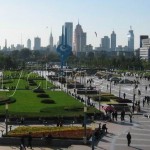Economy of Xiamen from 2000 to 2011- Focus on international trade (2)
Imports and exports
– General situation
As a harbour city, Xiamen takes advantage of privileges as a SEZ and FTZ to pull its economic development, table 1 shows how imports and exports changed respectively and totally during past 10 years, we can see an obvious trend from Figure 4 that Xiamen’s trade growth rate fluctuated fiercely in 2003 and 2008, the former one is because of occasion of SARS infection and Iraq war, shaking slightly oversea demand and raw material price, so a good economic environment should always be on the basis of stable political circumstance and peaceful natural environment. while the decrease in 2008 is obviously on account of American financial crisis, which create an unprecedented hit to the world economy, but the influence on Xiamen seemed to be not too serious , from Figure 3 it can be seen that Xiamen’s total imports and exports recovered in just 1 year followed by tremendous increment in next two years (surpassed other 3 sub-provincial harbour city and became the second largest increment next to Ningbo in 2010), resulting from prosperous political environment and policy support, especially government financial support. It is said that Xiamen totally obtained 504 million RMB as support fund for its foreign trade department.

– Imports from Taiwan
The policy on trade between China mainland and Taiwan is always a social focus, and Xiamen has become the first beneficiaries since ‘channels’ were unblocked, the most obvious point reflected on imports from Taiwan. As figure 5 shows, the imports climbed slightly from 2000 to 2006, and dramatically from 2007 to 2010, which can be attributed to political policy called “Santong” (more communication on business, travel, and post). What’s more, Xiamen even organized export exhibition focus on Taiwan every year to attract more Taiwan businessmen and companies that have long-run development plan to promote more cooperation. So it is not surprised in 2010 Taiwan took place of Japan and became the second trade partner of Xiamen, and it also the first time to outnumber 5.32 billion dollars, the increment exceeded average level in the whole province, meanwhile, the total imports and exports from Taiwan in 2010 covered 61.4% of that in Fu jian Province and 4.4% of China. In a near future, Taiwan may be the first trade partner of Xiamen with more diverse product allowed to transport and more open policy building a broader bridge over Taiwan Strait integrating two parts gradually based on the same language, culture, and prosperous future.
– Exports from Emerging markets VS traditional markets VS traditional markets
Emerging markets include Southern Common Market, five African countries, Russia, India, etc. While developed markets mainly contain United States, Europe Union, and Japan. Traditional markets are Association of Southeast Asian Nations (ASEAN), Hong Kong, Taiwan. Figure 6 displays apparent comparison among three different markets. Clearly, emerging markets grew increasingly from 2001 to 2004 since it has largest potentiality with small transaction at the beginning, while traditional markets grew with fluctuated growth rate. However, during 2006-2010, emerging markets gradually perform outstanding during three markets and climbed all the time regardless of economic crisis in 2009, when other two markets started to declined. Amazingly, in 2010, exports growth rate of emerging markets reached nearly 60% leaving other two markets far behind with 15.89% and 24.7%. This distinct change also because economic crisis, and the two markets has already been full since more than 10 years’ transaction, especially after a recession hit, but for emerging markets, demand just started to be discovered and still have large space to be discovered. However, what shall be attended is that even though emerging market increased explosively, the total exports is just 1.86 billion dollars until 2010, while developed market reached more than 2 billion dollars and traditional markets 7 billion dollars. So we can predict emerging markets is still on the way.














